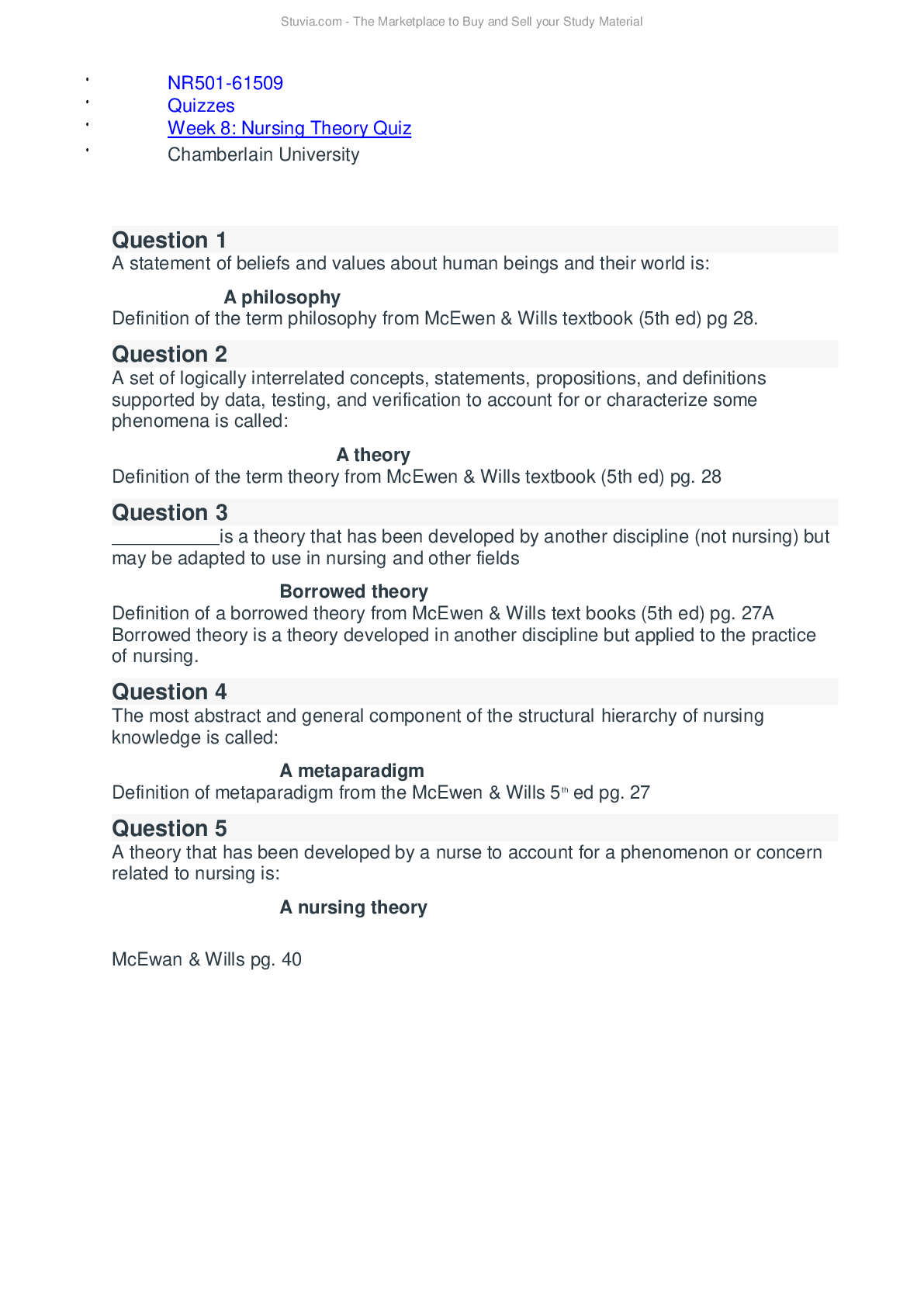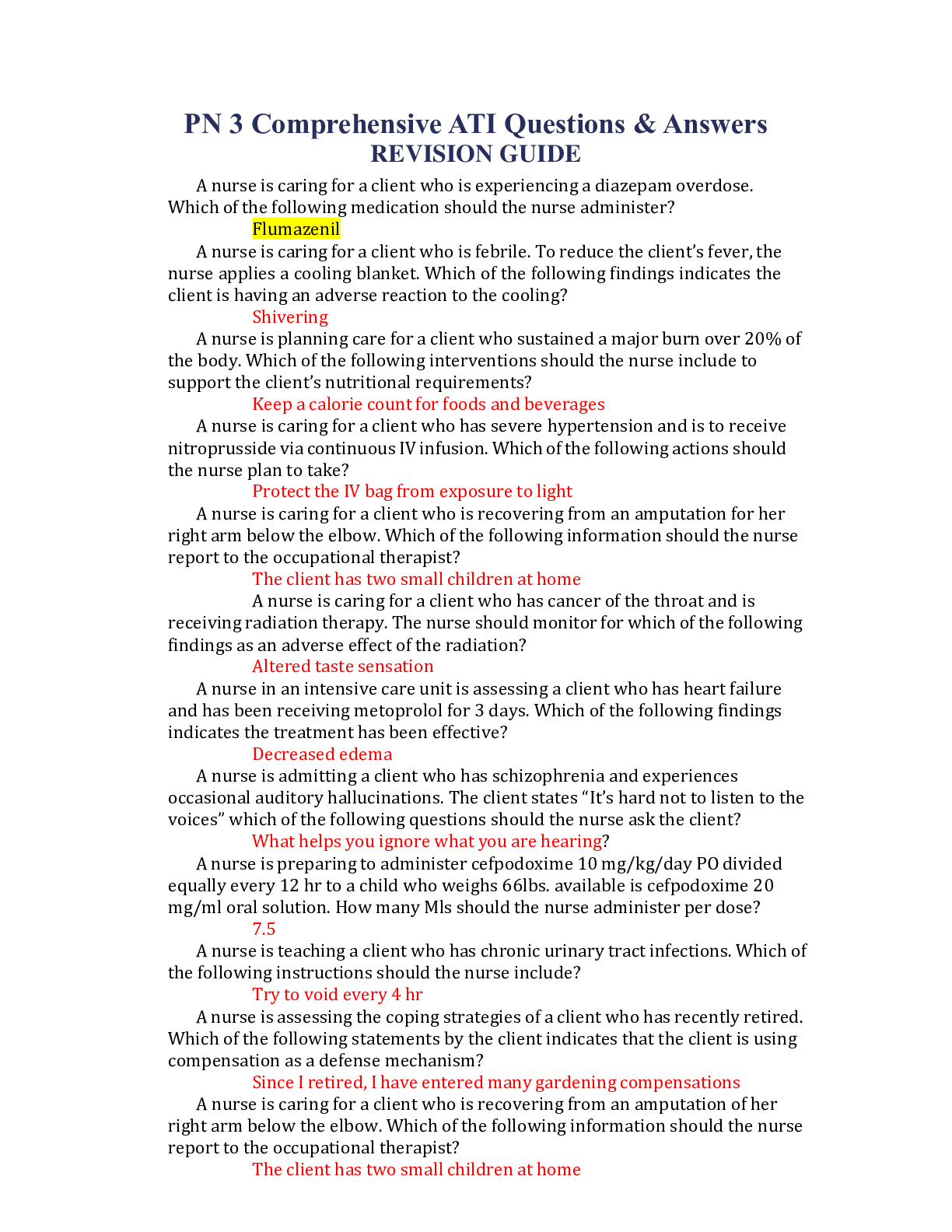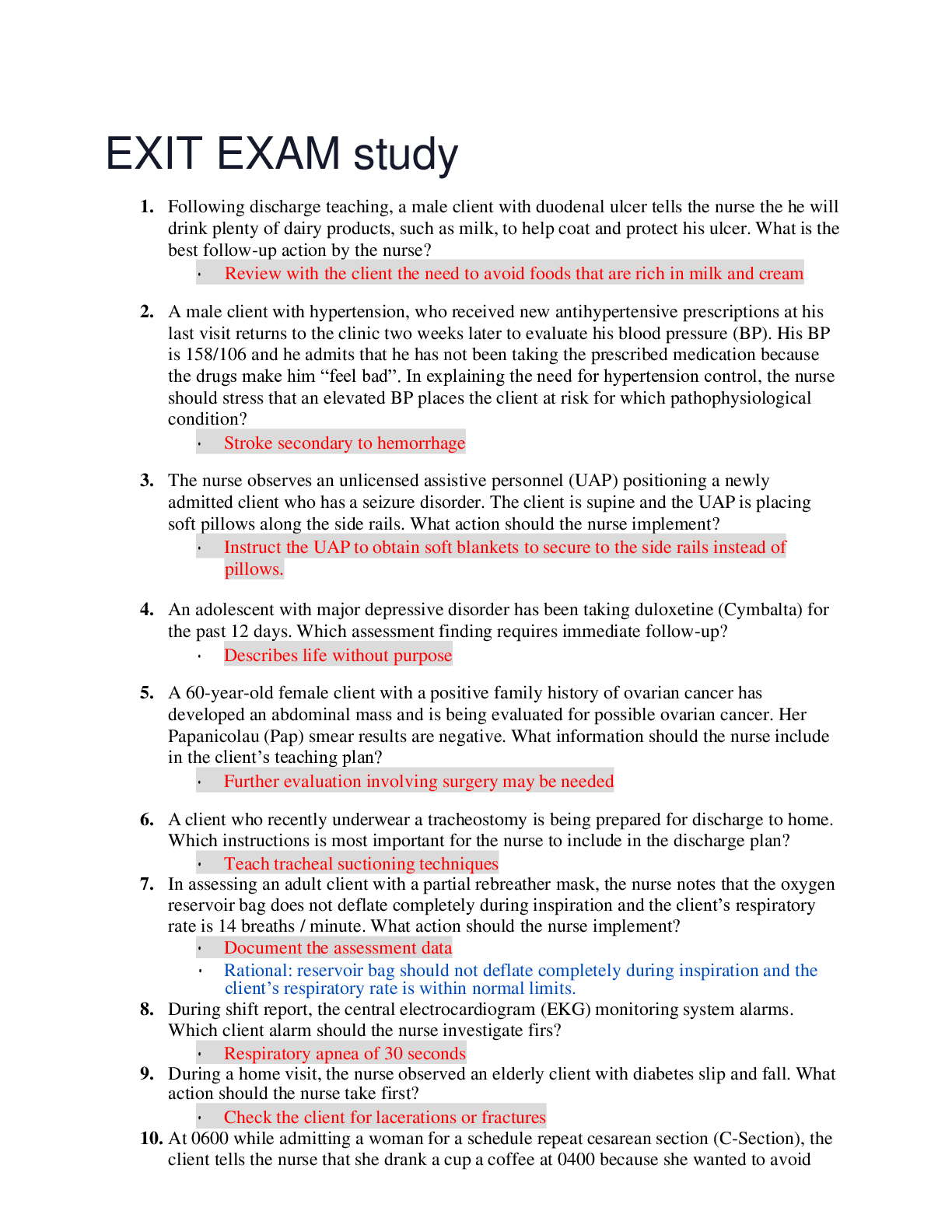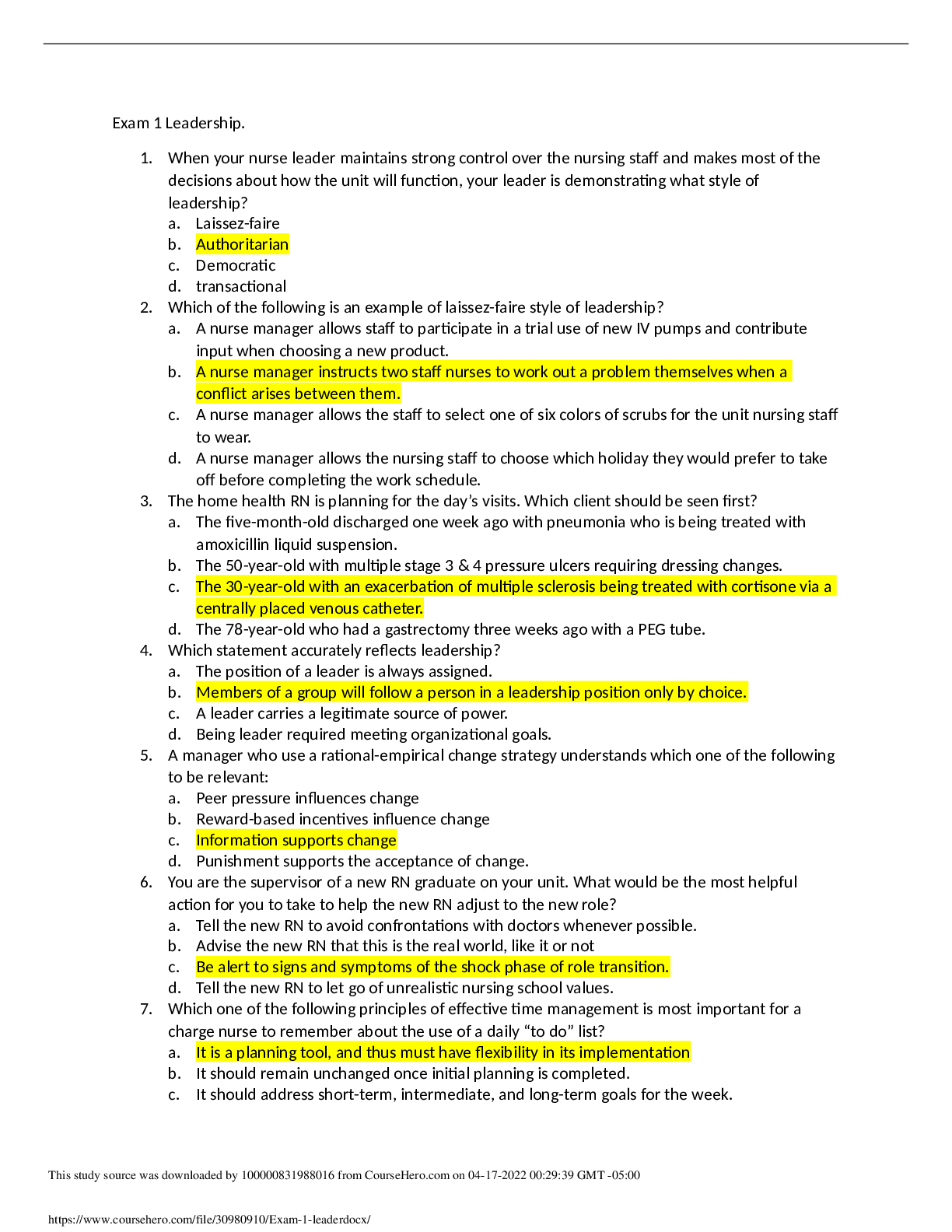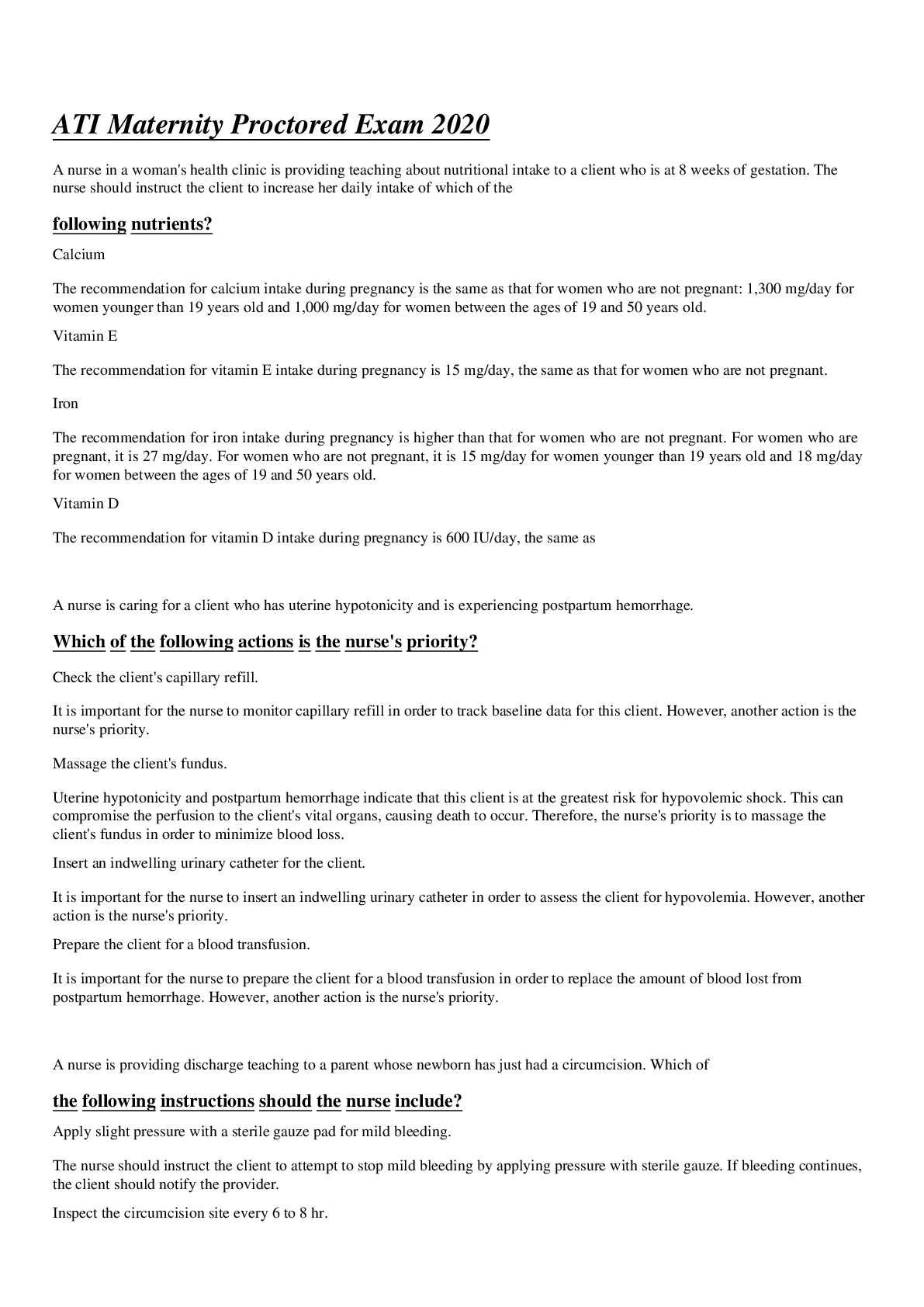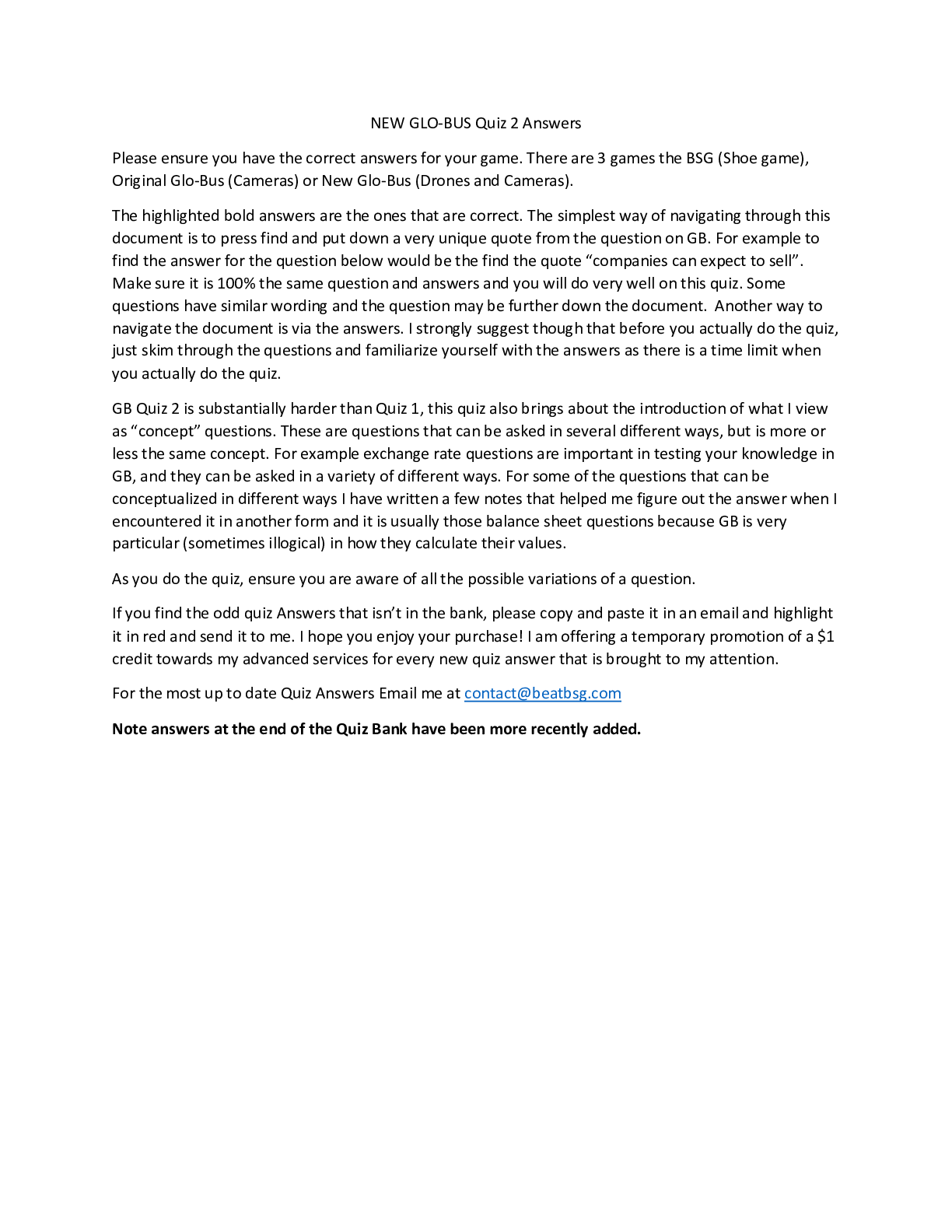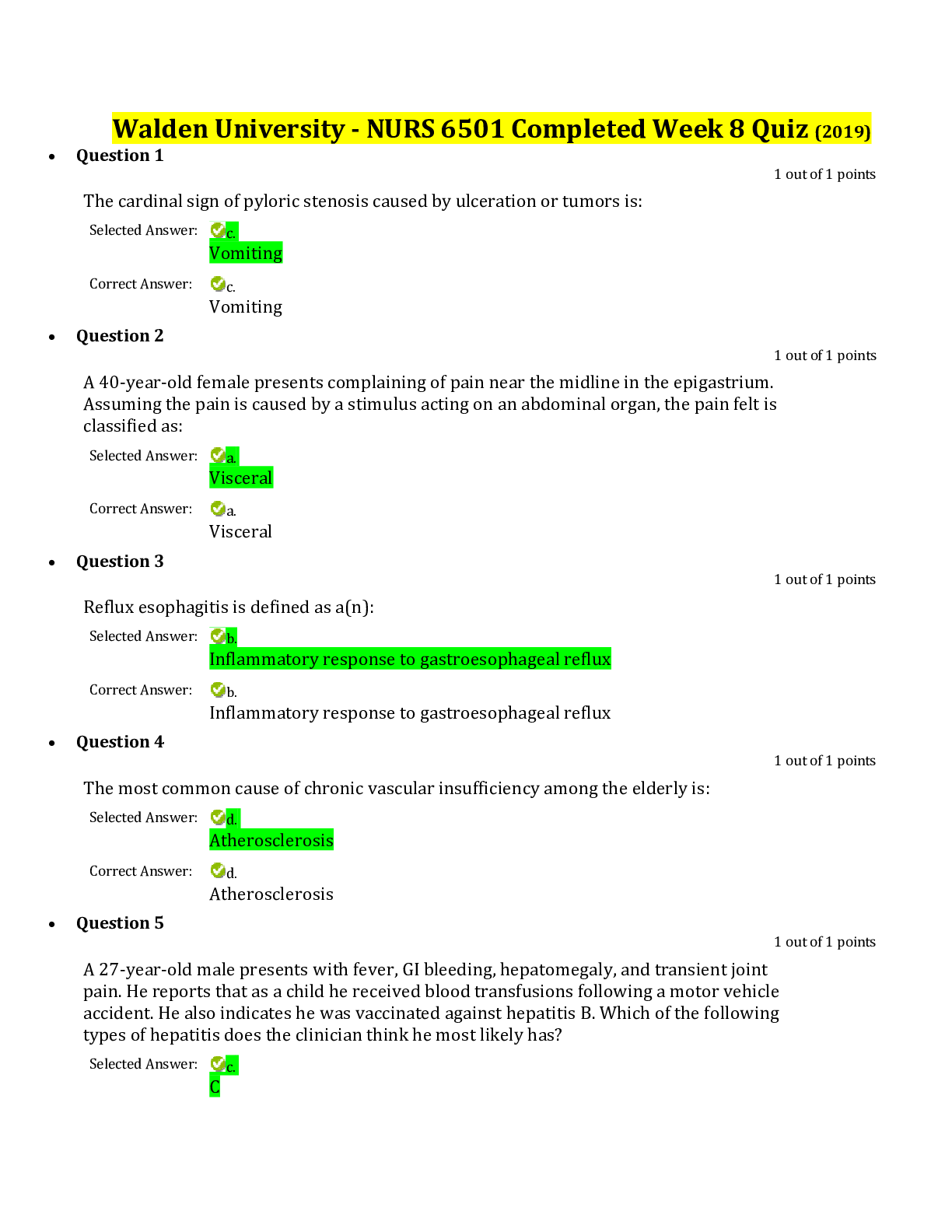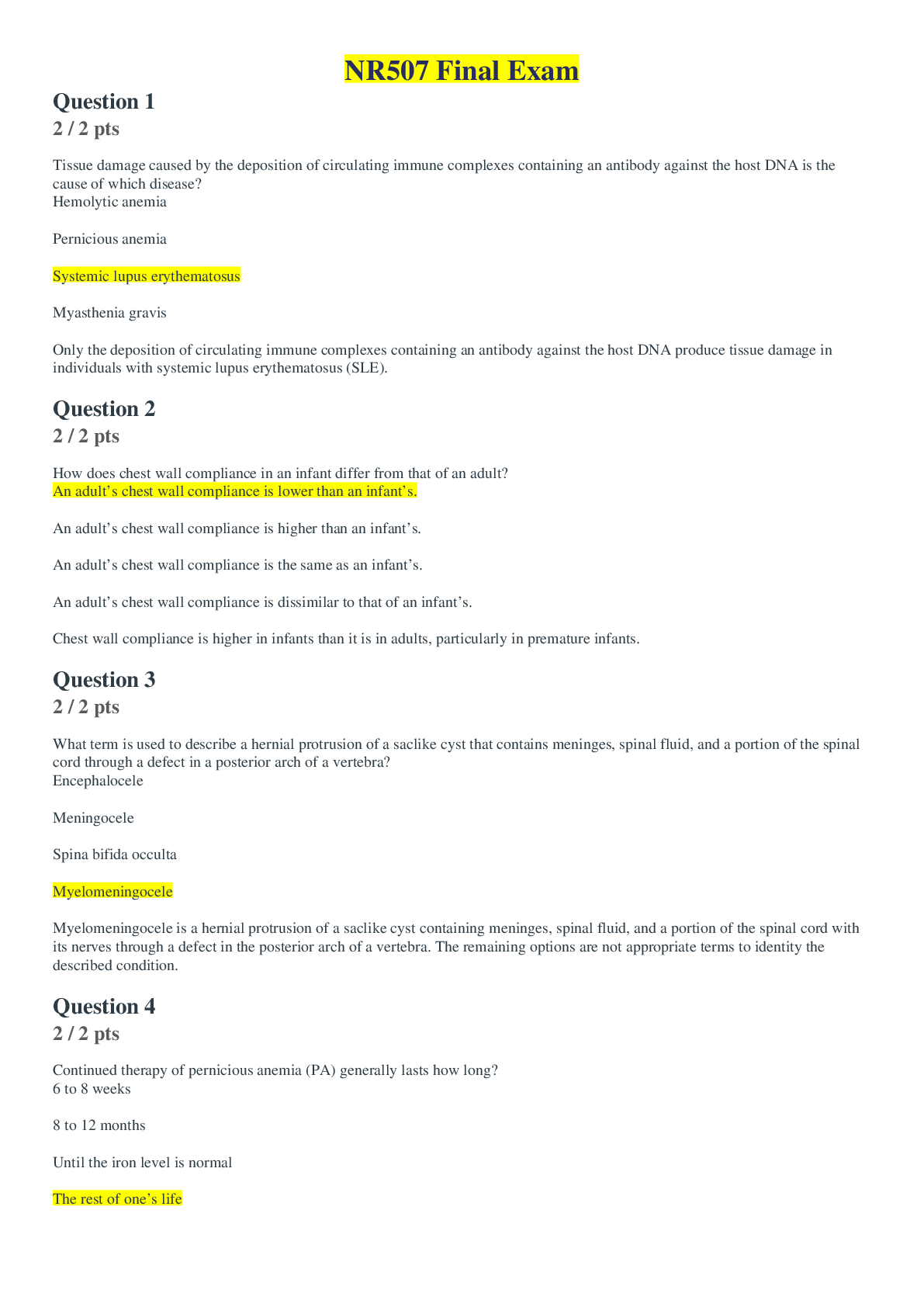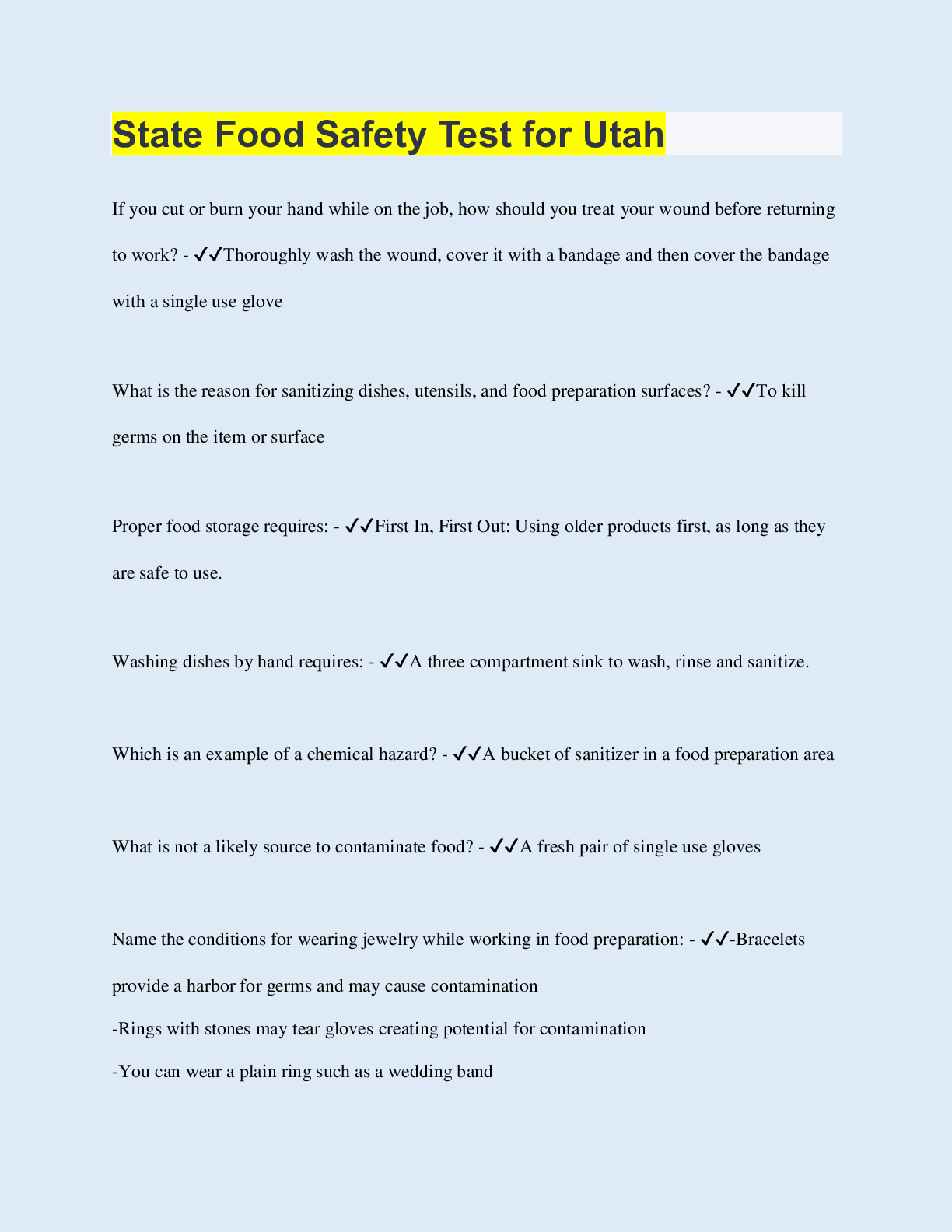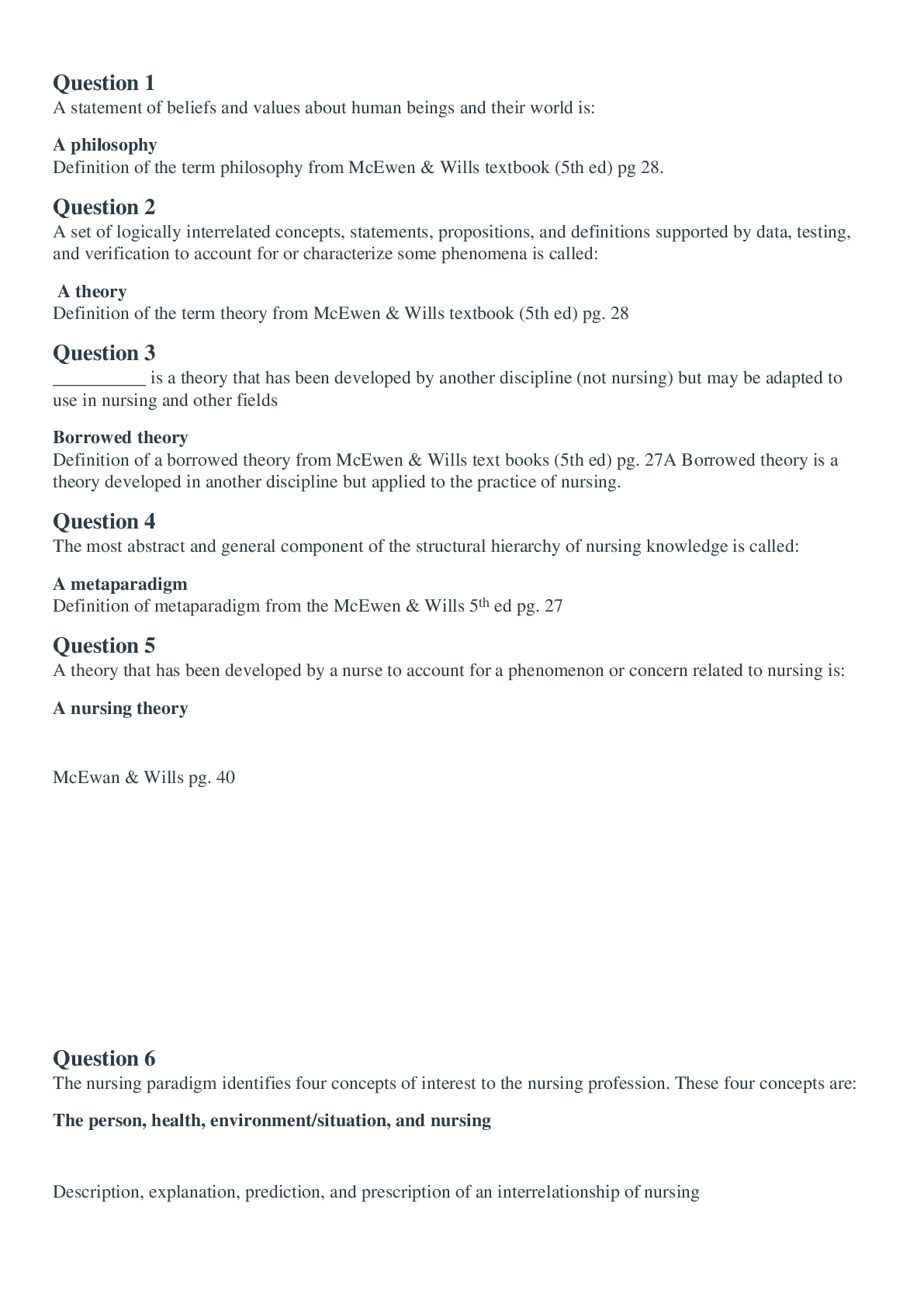Sociology > EXAM > SOCS 185N Week 8 Quiz (100% Correct) | LATEST UPDATE | DOWNLOAD TO SCORE AN A (All)
SOCS 185N Week 8 Quiz (100% Correct) | LATEST UPDATE | DOWNLOAD TO SCORE AN A
Document Content and Description Below
SOCS 185N Week 8 Quiz (100% Correct) (TCO 8) The natural growth rate of a population is derived from the subtraction of the crude death rate from the crude birth rate. crude birth ra... te from the crude death rate. net death rate from the gross death rate. net birth rate from the gross birth rate. live fish rate from the gross net weight. Chapter 15 (TCO 8) The basic idea behind demographic transition theory is population patterns reflect a society’s level of technological development. population increase will outstrip the planet’s ability to support us. population increase is now mostly in high-income nations. population decrease is now mostly in low-income nations. population size ebbs and flows between one equilibrium and another. (TCO 3) A riot differs from a mob in that the riot is not usually violent. typically has little focus or clear goal. involves fewer people. is very rare in U.S. history. is often expressed in a different language Chapter 16 (TCO 3) Durkheim’s is similar to Tennies’ . mechanical solidarity; Gesellschaft organic solidarity; Gesellschaft Countach; Boxter social solidarity; Gemeinschaft organic solidarity; Gemeinschaft (TCO 8) Which English economist and clergyman warned that rapid population increase would lead to social chaos? Fredrick Engles Thomas Robert Malthus Les Ismore Paul Ehrlich Ralph Nader Chapter 15 (TCO 3) What is a criticism that is sometimes made of Weber’s work? The inequality he attributed to alienation actually stems from social bureaucracy. The bureaucracy he attributed to alienation actually stems from social inequality. The inequality he attributed to bureaucracy actually stems from social alienation. The alienation he attributed to bureaucracy actually stems from social inequality. The bureaucracy he attributed to inequality actually stems from social alienation. Chapter 1 (TCO 3) Which theory states that social movements arise among people who feel they lack enough income, basic rights, or human dignity? Resource deprivation theory Relative mobilization theory Relative deprivation theory Resource mobilization theory Resource relativity theory Chapter 16 (TCO 8) Which sociologist pointed out that material culture changes faster than nonmaterial culture? Talcott Parsons Thorstein Veblen Theophilous Punoveall Erving Goffman William Ogburn Chapter 16 (TCO 3) The concept postmodernity refers to which of the following? The material objects of societies that are already industrialized. Practices of societies that are just beginning to have computer access. The cultural traits of societies that keep their traditions. The norms and values of societies that are just beginning to industrialize. The cultural traits of postindustrial societies. Chapter 16 (TCO 8) Which type of social movement seeks radical change in all of society? Alternative social movements Redemptive social movements Reformative social movements Revolutionary social movements Reactionary social movements Chapter 16 (TCOs 1, 2, 3, and 4) Describe and give an example of each of sociology’s three research orientations. Your Answer: The three sociology's research orientations are Critical Sociology, Positivist Sociology, and Interpretive Sociology. Critical Sociology defines a type of society which has inequality patterns. In some scenarios, a set category of people are more dominate than others. In this case, they take a social conflict approach. Positivist Sociology is defined by the study of a company in an orderly system having an objective reality "Out There." This research orientation supports the structural-functional criteria. When discussing the Interpretive Sociology, we are describing the ongoing interaction concept of society. This type of society is relative to people attached to their behaviors. The researchers are more focused on the subjective meaning and follow the symbolic interaction approach (Macionis, 2016). Chapter 1. Answer should include the following: positivist sociology, based on science; interpretive sociology, based on the meanings that people attach to behavior; and critical sociology, based on bringing about social change. (TCOs 3 and 8) You have been asked by a committee of student success coaches to investigate why the rate at which freshman students post to their course threaded discussions is lower than the rate for other groups of students. Explain how the structural-functionalist perspective would analyze and explain the low posting rate. (In other words, consider the contributing factors that the structural-functionalist perspective would focus on in trying to explain the reasons for the low rate of students posting to their threads.) Then discuss a solution that a functionalist might use to encourage freshman students to post. Your Answer: Freshman are new in take and nearly less comfortable and acquainted with the social capacities and social norms that dictate the society of a new classroom environment as the freshman adjusts. When you first come into something new and fresh, the student may dread posting due to thinking they would be judged for posting the wrong answer or simply making a mistake. This restrains the student from participating in the discussion post. The two mainstays of the functionalist perspective are solidarity and stability. I think if it's made known that when completing post that it's alright to commit an error because everyone is present to learn and that it's only one instructor who will explain the post. Another suggestion would probably be to put emphasis on the importance of cooperation and collaboration. When the instructor is specific with instructions and allow the focus to not be solely on the educator it should encourage peer to peer interaction. Chapter 1 covers the basic elements of the core sociological theories. In addressing the first part of this question, students will need to demonstrate that they understand the basic ideas and concepts of functional theory. In addressing the second part of this question, students will need to demonstrate that they can offer a solution to the problem based on functionalist theory. (TCOs 6 and 7) Explain each of Peter Berger’s four major characteristics of modernization. Your Answer: Peter Berger recognized four major features of modernization are: 1. The refusal of small conventional communities, 2. The development of individual option, 3. The rising communal diversity as well as direction towards the prospect, and 4. The rising consciousness of instance. Chapter 16. Answer should include an explanation of: decline of small traditional community, expansion of personal choice, increasing social diversity and future orientation, and a growing awareness of time. (TCOs 3, 4, and 6) List and describe the stages that societies go through in Lenski’s sociocultural evolution. Your Answer: The Stages of Lenski's Sociocultural Evolution that Societies go through are hunting and gathering, pastoralism and horticultural, agricultural, industrial, and post-industrial. 1. Hunting and Gathering is a society where people use to earn their livelihood by hunting wild animals and gathering food or vegetation found in the wild. 2. Pastoralism and Horticultural is a society where domestication of animals is a practice that is common as well as cultivation of crops by use of hand tools to help source livelihood. 3. Agricultural is a is a large-scaled society where cultivation is practiced by the use of plows pulled by animals or more powerful sources for the livelihood of the people. 4. Industrial society is where the production of goods were made when the sources of energy began to advance from animals to large machinery ran by coal, water, and steam. 5. Post-industrial society is when the society began to process information through computer technology. This was done by way of factories and other electronic devices. Chapter 2. Answer should include: Hunting and Gathering: nomads of kin living off of what was available; Horticultural and Pastorialism: plant seeds, grow crops, domestication of animals, use tools, and less nomadic; Agriculture: larger scale farming with human and animal power; Industry: advanced fuels and machinery to produce goods. (TCOs 5, 6, and 8) Identify and briefly explain the four principles that underlie social stratification. Your Answer: Social stratification is a system through which society ranks categories of people in a hierarchy. The four principles that underlie social stratification are that 1) Social stratification is a typical trait of society not only due to the singular differences. 2) Social stratification hold on to generation eras. This simply means that is carries over from generation to generation. The change in social mobility varies from upward or descending levels. 3) Social stratification is all-inclusive yet it factors from one society to another. In other words, what is unequal or how unequal it is varies. Chapter 8 (1) Social stratification is a trait of society, not simply a reflection of individual differences. (2) Social stratification carries over from generation to generation. (3) Social stratification is universal but variable. (4) Social stratification involves not just inequality but beliefs as well. . Quiz Score: 235 out of 250 [Show More]
Last updated: 1 year ago
Preview 1 out of 9 pages
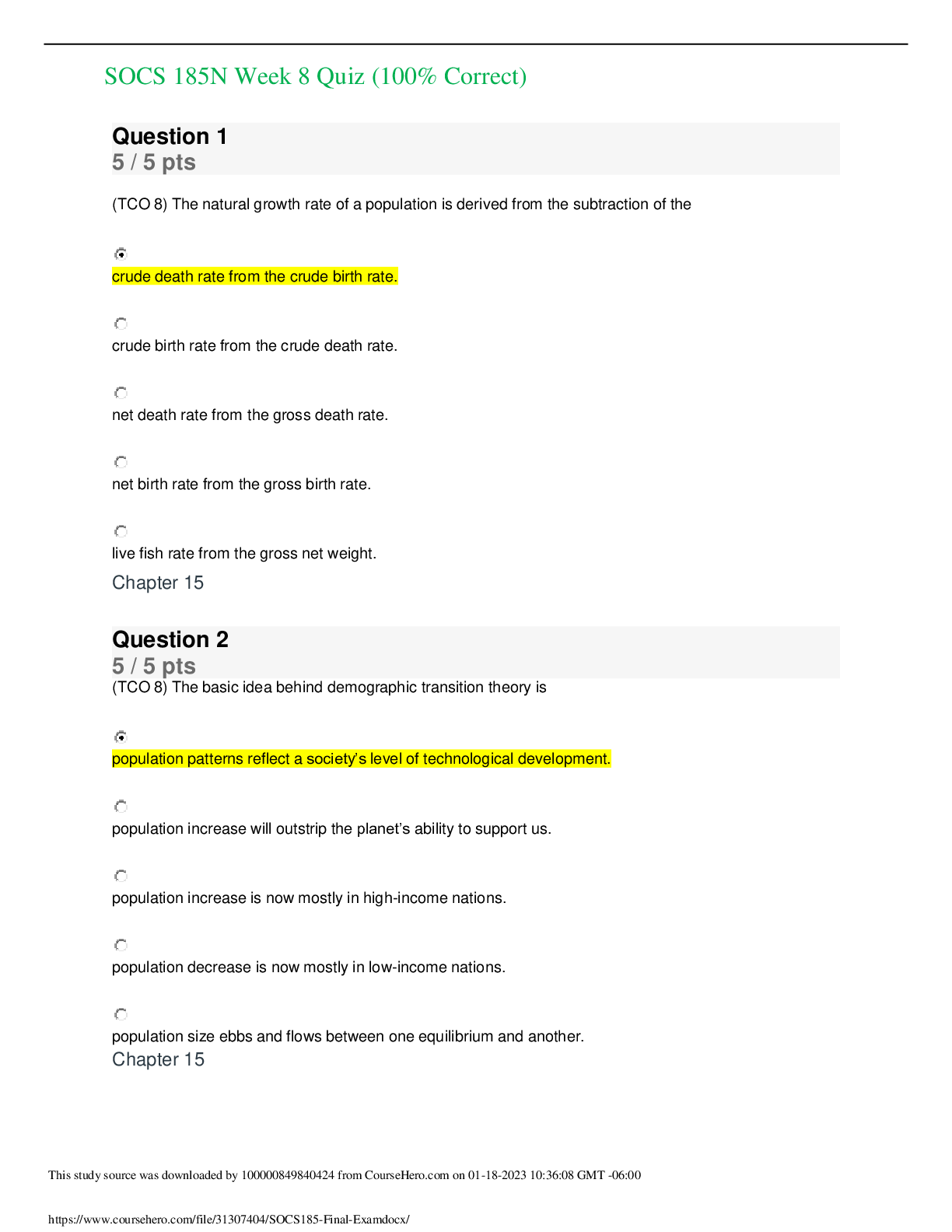
Reviews( 0 )
Document information
Connected school, study & course
About the document
Uploaded On
Jan 18, 2023
Number of pages
9
Written in
Additional information
This document has been written for:
Uploaded
Jan 18, 2023
Downloads
0
Views
51






.png)












.png)

